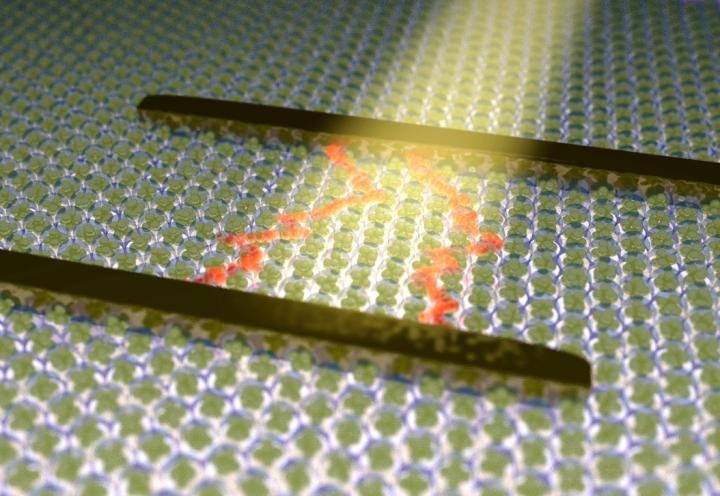Mar 27 2019
A joint Swansea-Hamburg research team has discovered that miniature nanoclusters of metal atoms—such as silver and gold—possess properties that enable them to be used as semiconductors.
 Scheme of the phenomenon: light, which strikes the films of nanoclusters, promotes the charge flow between the two electrodes. (Image credit: Galchenko/Klinke: University of Hamburg/Swansea University)
Scheme of the phenomenon: light, which strikes the films of nanoclusters, promotes the charge flow between the two electrodes. (Image credit: Galchenko/Klinke: University of Hamburg/Swansea University)
This discovery makes room for a variety of potential new applications ranging from flatter screens and phone displays to wearable technology.
Semiconductors are considered to be at the heart of the latest electronics. Some of their common applications are in light detectors, display devices for televisions and mobile phones, and solar cells for producing energy.
Colloidal quantum dots and organic semiconductors are the two key types of particle-based semiconductors already being used. These materials are at the nanoscale and their small size means they are subject to a phenomenon called quantum confinement, which brings about alterations to their electronic and optical properties. These changes make them ideal for their proposed applications.
Metal nanoclusters integrate features of both these materials. Similar to colloidal quantum dots, they are highly stable. Like organic semiconductors, they are molecular, or atomically precise, containing a particular number of atoms in their metallic core.
However, in spite of containing all the correct ingredients, metal nanoclusters had never earlier been demonstrated to exhibit semiconducting properties.
The Swansea-Hamburg team achieved the progress precisely in this aspect.
The group formulated a way of creating films of nanoclusters composed of 25 gold atoms (Au25). They then learned that the nanoclusters exhibited semiconducting properties. They also particularly observed field effect and photoconductivity in phototransistors developed from these films. These unique properties are trademarks of all semiconducting materials.
The team comprises of scientists from Swansea University’s chemistry department and the University of Hamburg in Germany.
Professor Christian Klinke from the chemistry department at Swansea University elucidated the possible applications of this finding:
“The discovery of semiconducting properties in metal nanoclusters could pave the way for a variety of new applications, from field effect transistors and photodetectors to light emitting diodes and solar cells. These devices could be manufactured on flexible bases. Many metal nanoclusters, including the ones we investigated in this report, have almost infinite stability, which could make them suitable for ink-jet printing applications. We need to build on this finding and refine the technique further. But this discovery points the way ahead. It shows that we can use metal nanoclusters to produce high quality semiconducting films that are easy to assemble.”
Other scientists from the group explained other possible applications:
Dr Andrés Black of the University of Hamburg said: “The affinity of the metal core to different molecular functionalities could make them highly sensitive gas sensors.”
Michael Galchenko, also of the University of Hamburg, said: “The integration with other low dimensional materials could yield heterostructures with new and interesting functionalities.”
Semiconductors are a big focus for our work here at Swansea, both in our chemistry department and our Centre for NanoHealth. Christian’s work is very exciting for next generation semiconductor materials—an area in which Swansea University is leading activity, with our industry partners. These findings, made possible by our close links with Hamburg, are a significant step forward in the field. It shows that for research, as for teaching, our chemistry department is at the forefront.
Professor Owen Guy, Head of Chemistry Department, Swansea University